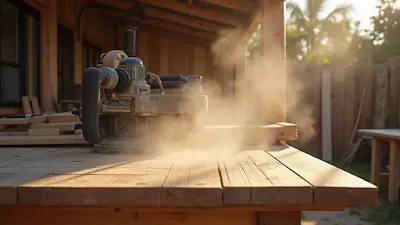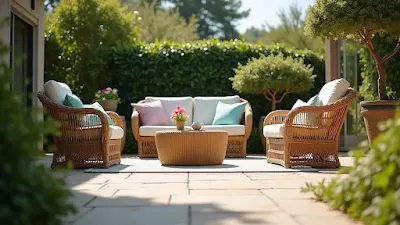Nestled against a backdrop of stunning landscapes, this wooden house is more than just a dwelling; it’s a masterpiece that captures the very spirit of the American West. With its rustic charm blended beautifully with modern design, this home connects seamlessly with nature, offering a luxurious living experience amidst tranquility. Imagine stepping onto a terrace that features an exquisite ipe wooden ceiling, a symbol of thoughtful architecture and sustainable living.
Let’s explore the design choices and features that define this remarkable space and highlight how it embodies style while respecting its environment.
The Allure of American West Style
American West style is all about nature-inspired elements, warm colors, and authentic materials. It invites the rugged comfort of the outdoors into the home.
In this stunning wooden house, expansive windows and open layouts create a light and airy atmosphere. They provide direct views of the breathtaking scenery outside, allowing residents to feel a constant connection with nature. Rich wooden facades add warmth and texture while maintaining modern functionality.
The materials used are essential to achieving this aesthetic. Natural woods, stone, and metal fixtures create a compelling mix of textures and styles that reflect the area’s heritage. For example, the use of reclaimed wood not only enhances durability but also tells a story of sustainability and history.
Emphasizing Connection with Nature
At the heart of the design is a commitment to creating a true sanctuary that fosters a strong bond with nature. The expansive terrace acts as a smooth transition between the home’s interior and the wild outdoors, offering residents a perfect space to enjoy their surroundings.
The ipe wood ceiling on the terrace is a standout feature, known for its incredible durability and resistance to the weather. This not only enhances the aesthetics but also aligns with sustainable practices. Ipe wood can last up to 75 years with minimal maintenance, contributing to the home’s longevity.
Curated outdoor seating areas create cozy nooks for relaxation, contemplation, or gatherings. Picture sipping your morning coffee surrounded by the sounds of rustling leaves and chirping birds. This setup not only serves as a personal retreat but as a venue for memorable evenings with friends and family.
The Transition Between Indoors and Outdoors
One of the most impressive features of this wooden house is its ability to blend indoor and outdoor spaces beautifully. Large glass doors open to the terrace, allowing abundant natural light to illuminate the interiors while providing breathtaking views of the landscape.
This design choice not only enhances visual appeal but also encourages a lifestyle immersed in nature. Whether enjoying a quiet morning or entertaining loved ones during sunset, this home sets the stage for a harmonious living experience.
The open floor plan flows easily from space to space, accommodating various activities. It is a perfect setting for both intimate family moments and larger gatherings with friends, fostering a warm, inviting atmosphere.
Thoughtful Landscaping That Complements the Home
The landscaping around the wooden house plays a vital role in magnifying its beauty. Thoughtfully crafted gardens filled with native plants reflect the local ecology and enhance the overall ambiance of the area.
Paths lined with wildflowers and ornamental shrubs lead the eye toward the house, creating a warm welcome for anyone who approaches. The landscaping isn’t merely an add-on but rather a carefully planned extension of the home that supports local wildlife and nurtures the environment.
Outdoor features such as a fire pit, with seating for gathering in cool evenings, or a small fountain that attracts birds, can transform the outdoor setting into a personal oasis. These elements connect residents to the heartbeat of nature, enhancing overall well-being.
Sustainable Living in the Wooden House
This wooden house’s thoughtful design aligns with contemporary principles of sustainable living. Built using environmentally friendly materials, it minimizes carbon output while maximizing comfort and visual appeal.
Choosing sustainable ipe wood for the ceilings reflects a commitment to eco-conscious living. This material not only enhances aesthetic appeal but also showcases durability. It is resistant to decay and pests, making it an ideal choice for long-lasting structures.
Furthermore, the strategic orientation of the home harnesses passive solar energy, absorbing warmth in winter and keeping it cool during the summer months. Integrating energy-efficient windows and appliances boosts this sustainability, making eco-friendly living a natural choice within the home.
Interior Design: Embracing the Spirited Aesthetic
Upon entering this remarkable home, you are greeted by spaces that celebrate American West style. Warm wooden beams and a soft, earthy color palette creating an inviting atmosphere instantly feel welcoming.
Open living spaces allow for a sense of flow, connecting different areas of the house. Cozy lounges equipped with soft, inviting furnishings create spots perfect for relaxation, while spacious areas are designed for lively social gatherings.
The decor showcases the region's rich culture and heritage. Art pieces that echo local history, intricate textiles, and handmade ceramics reflect a strong connection to the surroundings, adding character and warmth to the interiors.
Embracing Modern Technology with Rustic Charm
While the wooden house roots itself in traditional charm, it skillfully integrates modern technology for a contemporary lifestyle. Smart home features, such as climate control and security systems, ensure that living here is not only comfortable but also efficient.
This blend of rustic aesthetics and modern conveniences perfectly suits today’s demands. Residents can bask in the warmth of a wooden home without compromising the convenience of modern technology. It creates an environment that is both timeless and forward-thinking.
Functionality remains at the core of every design choice, creating a harmonious atmosphere that enhances daily life while maintaining an elegant style.
Optimal Use of Natural Light
Strategic design enhances the impact of natural light throughout the wooden house. Large windows, skylights, and glass doors invite sunlight into every corner, creating an uplifting ambiance.
Natural light not only beautifies interiors but can significantly influence the residents' mood and mental well-being. Research indicates that exposure to natural light can elevate mood and increase productivity, essential for a balanced life.
During warmer months, the ability to open the home to fresh air creates an impression of outdoor living while ensuring comfort inside, year-round. This intuitive design reflects the philosophy of harmonizing with nature and elevates living experiences.
A Testament to Nature and Craft
This beautiful wooden house stands as a striking example of how American West style and modern living can harmonize. With design choices that embrace nature, thoughtful material selections, and a seamless indoor-outdoor connection, it offers a unique environment that enriches the lives of its residents.
The terrace, adorned with an ipe wooden ceiling, invites you to soak in the beauty of your surroundings. These features illustrate creativity and sustainability, highlighting that a home can be both stunning and eco-friendly.
As we enter an era focused on nurturing our relationship with nature, this wooden house serves as a model for what is possible. It encourages us to rethink how we build, live, and connect with our environment, creating spaces that bring peace and inspiration.

















